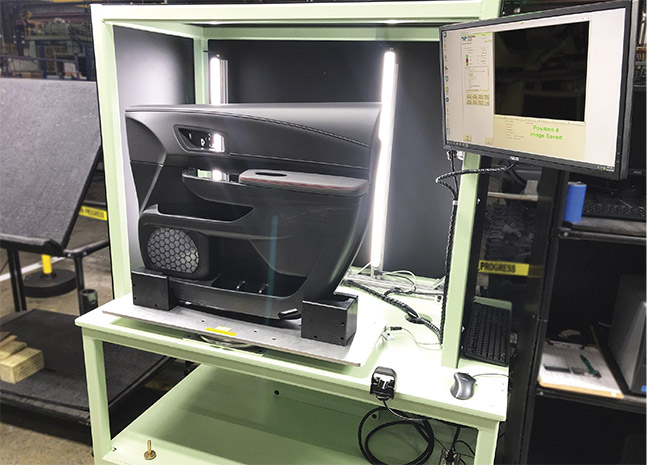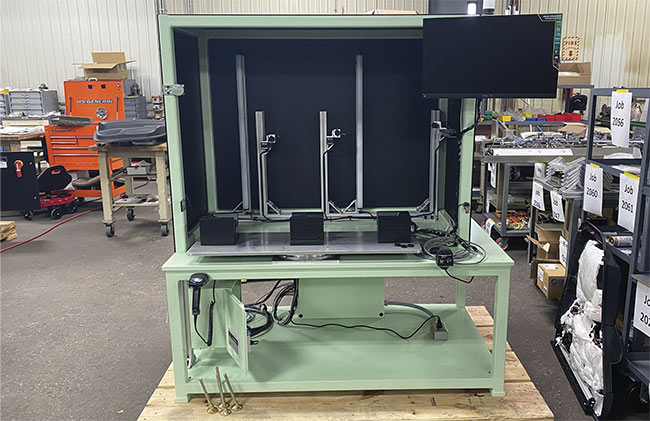HANK HOGAN, CONTRIBUTING EDITOR
Sometimes the right picture is all the proof that is needed.
Craig Machinery & Design, based
in Louisville, Ky., builds automation equipment for manufacturers and
specializes in the plastic components used in vehicles, appliances, and
medical devices. The firm focuses on ultrasonic and vibration welding of plastics.
Machine vision is used to check for the presence or absence of parts, to detect defects, and to perform other tasks that play an important role in the operation. A number is extracted by taking a measurement, and the data is stored, but the image is not.
Such typical machine vision tasks, however, were unable solve a problem faced by a customer of Craig Machinery that manufactures polypropylene door panels for cars and other vehicles. These panels are snapped into a metal frame, leaving part of the panel visible to the consumer. The panel size varies because it must match the vehicle door, but its length could be several feet on a side. Across the entire visible area, the panel must be scratch-free. This presented a problem for the panel manufacturer, which requested Craig Machinery’s help.

A vision system captures and stores images of a completed door panel, providing proof that the plastic panel is scratch-free after manufacturing. An operator manually rotates the fixture, which is mounted on bearings, so that the entire panel can be imaged at high resolution. Courtesy of Craig Machinery.
The manufacturer needed a way to verify that the parts remained in good condition and free of scratches when they were packaged. “They were large plastic parts that were getting scratched in shipping or by the final production line,” said Craig Rabeneck, president of Craig Machinery.
Proof on file
Images that provided the necessary proof needed to be stored and kept available for about year after a panel’s date of manufacture, because assembly of the panel into a car may take that long.
The system had to be easy to use and, most critically, the images that it captured had to be of high enough resolution to ensure that the presence or absence of scratches could be easily determined.

An inspection setup for imaging door panels at high resolution using three 18-MP cameras, which are visible in the back of the enclosure. Courtesy of Craig Machinery.
Craig Machinery considered several
alternatives before deciding on a
solution based on Teledyne DALSA products. Rabeneck said the deciding
factors were the cost of Teledyne’s
system, the high resolution of the
images that it produced, and its ease of use, which he attributed in part to the fact that it was PC-based. According to Brett Bergner, a technology consultant with automation solution distributor C&E Advanced Technologies, the solution involved three 4912- × 3684-pixel Genie Nano cameras. C&E helped Craig Machinery develop the system.
After the barcode image is taken, an operator manually spins the part around on a turntable and takes the other images using a wide-angle lens, ensuring that the entire panel is captured in high resolution.
The 18-MP cameras connect to a GEVA multicamera vision controller running iNspect Express software, which manages imaging, data storage, and other aspects of system control. Industrial LED lighting from Banner Engineering provides illumination and, if needed, can also alert the user about matters such as errors or the completion of imaging steps, for example.
During operation, the system takes six pictures, the first one of the panel’s barcode. The software generates a unique name from the barcode, and
the images are stored in a folder
labeled with the name. After the barcode image is taken, an operator manually spins the part around on a turntable and takes the other images using a wide-angle lens, ensuring that the entire panel is captured in high resolution.
“The vision system monitors the position of the turntable and prompts the operator through each step of the image-capture process,” Bergner said.
He added that technical assistance and other support from Teledyne DALSA were critical to the project’s success, and that the concept of a product audit trail could be useful whenever a high-value part was being shipped to an end customer, or for
assembly into a final system. Possible applications include electronic
assemblies and medical device packaging.
The customer has been using the high-resolution imaging system from Craig Machinery for several years,
Rabeneck said. Data is stored on off-the-shelf devices that use standard USB interfaces, providing an inexpensive and easy-to-use solution.
If questions come up about damage
to a particular panel, the stored high-resolution, time-stamped images can verify the part’s condition when it left the manufacturer. Details about the customer’s return on investment after purchasing the vision system are
confidential. However, Rabeneck said there is at least one indicator that
the return has been substantial: The
company bought more inspection
systems.